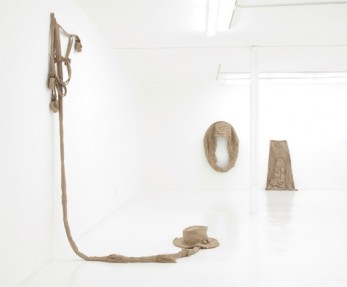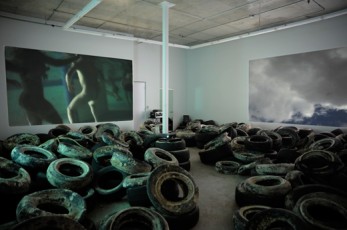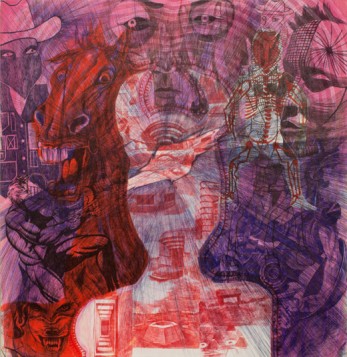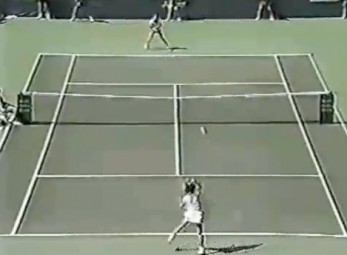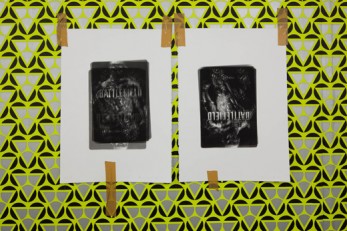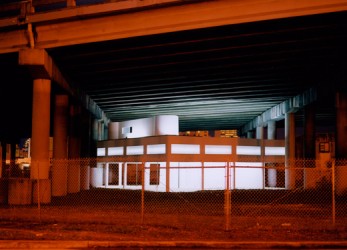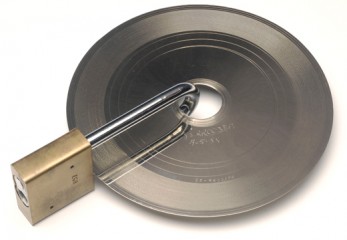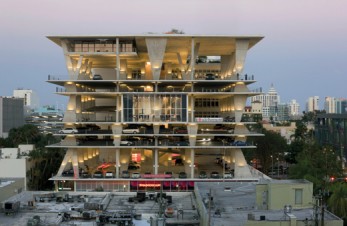The Everglades are wild. Designated a Wilderness Area in 1978, the Marjory Stoneman Douglas Wilderness Area comprises the vast majority of Everglades National Park and is by far the largest Wilderness Area east of the Mississippi.
LAURA A. OGDEN’S SWAMPLIFE: PEOPLE, GATORS, AND MANGROVES ENTANGLED IN THE EVERGLADES
Melissa Memory
Out of Place features ten sculptural wall works constructed almost entirely out of burlap. As a distinct shift in practice for Gast, this new body of work was conceived through an intuitive process of exchanges, meditations, and transformations in and around the artist’s studio.
As part of Hannes Bend’s first solo exhibition in Miami, he dredged up nearly a hundred tires from the failed Osborne Artificial Reef off the coast of Fort Lauderdale. Begun in 1972, the Osborne Reef is composed of between one and two million discarded car tires that were supposed to foster aquatic life that sport fishing was decimating, but this never happened.
Although this sprawling show treads close to self-parodying the avant-garde, underground, and their attendant deviances, it ultimately succeeds in unraveling something in the viewer’s sensibility untouched since the excesses of the late New York school.
On March 10, 1990, my mother was in the stands at the Polo Club of Boca Raton for the semifinals of the Virginia Slims of Florida Women’s Tennis Tournament. Sitting directly behind her was the New Age composer Yanni and his girlfriend at the time, Dynasty actress Linda Evans.
In Sweden, amidst a right wing government and budget cuts in cultural sectors, Tensta Konsthall Director and Curator Maria Lind launched an exhibition that brought heated debates about art and the economy to the fore. Like many European countries, especially those in Scandinavia, Sweden has had a fairly well-sponsored cultural sector powered by economic prosperity and social democratic politics.
Out my window, another one bites the dust, another surrender to spring. It’s the new moon, and according to all the art people who are into astrology lately it’s gonna be a good one.
In George Sánchez-Calderón’s version of history, the conquistadors, hitherto pleased with the trade winds pulling them across the Atlantic, would be caught in an inexplicable yet suicidal traffic jam somewhere off the coast of Miami. The ships would still be there today.
On the occasion of The Record: Contemporary Art and Vinyl, a traveling exhibition originating at the Nasher Museum of Art and currently on view at the Miami Art Museum, where it was organized by Rene Morales, artist Nicolas Lobo discusses the intersection of objects, sound and history with artist and audiophile Jay Hines, fictitious funk and soul recording artist Mingering Mike and the show’s curator Trevor Schoonmaker.
Since objectivity so embarrassingly often gives the slip to those who speak in its name, I’m happy to propose the following as fantasy: there was a moment in which Miami visual artists had an opportunity to participate in giving form to that subterranean, amorphous, slippery Thing that makes a city distinct. Some would call this Thing a city’s identity.
My several earlier visits to Miami were more motivated by sunlight than art, so any prior perspectives on the city were built upon a platform of ignorance mixed with objectivity. As such, these thoughts of a Northern visiting writer emerged from three cloudlessly enjoyable days in late April — an enlightening opportunity to sample (in very affable and erudite company) the city’s thriving cultural scene.
While I was in Wynwood, Miami for the opening reception of a friend’s one-person exhibit at Nina Johnson’s Gallery Diet, Nina’s husband, the artist Daniel Milewski, invited me to give a reading at his venue Lester’s (the neighborhood’s equivalent of fin-de-siècle Paris’s Deux Magot or, for that matter, mid-’90s Williamsburg’s L Train Café).


